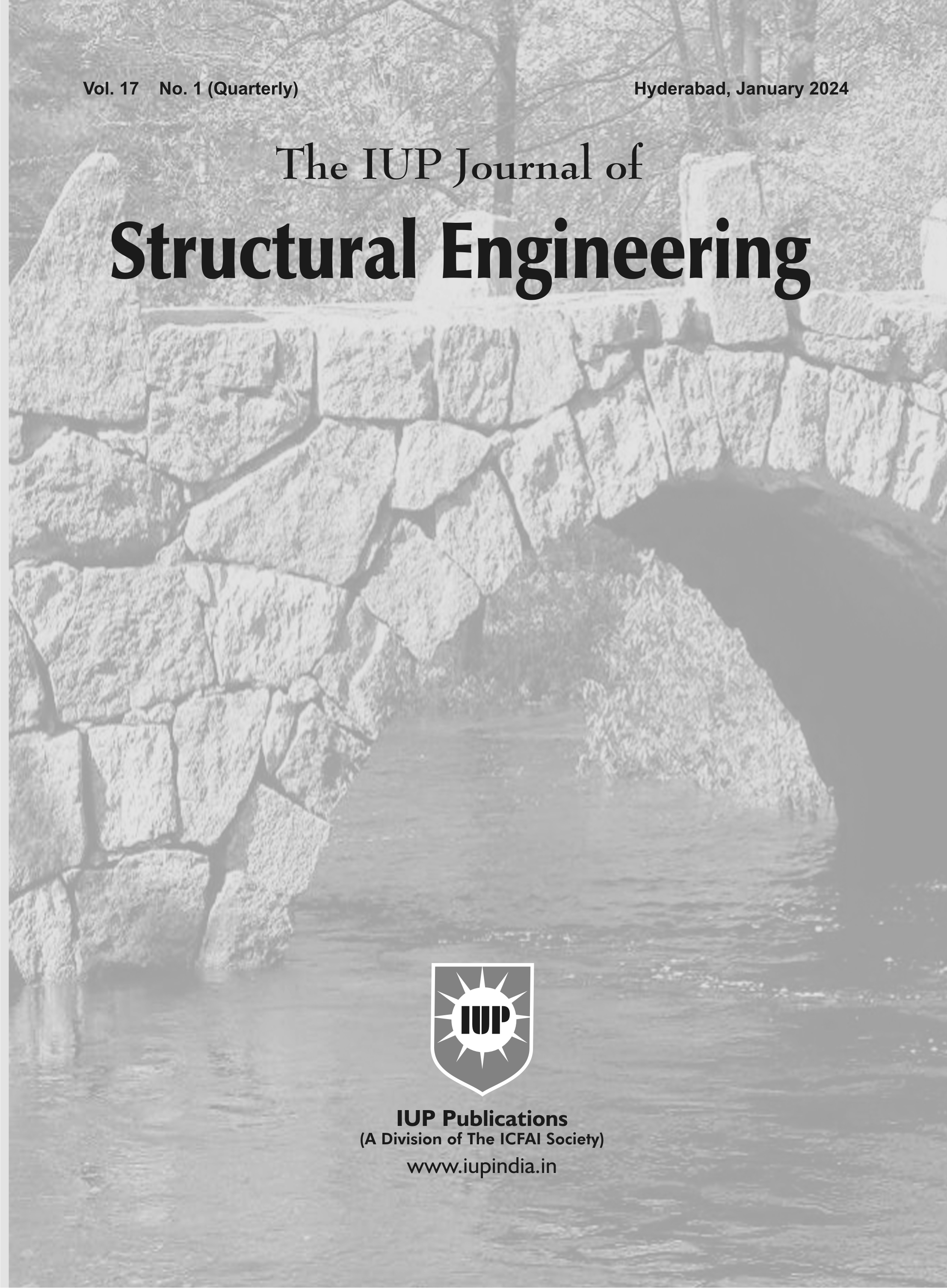
Jan' 24
The IUP Journal of Structural Engineering
Focus
The reaction forces and gravitational deflections were incorporated in the history output. The load deflection behavior of the beam, S-tresca and equivalent plastic strain were created and examined for load increments. Several curves like load versus deflection, stress versus strain, S-tresca stress versus time curve, equivalent plastic strain versus time curve were also plotted for studying.
The second paper, "Flexural Behavior of Castellated Beams: An Experimental Study" by Saravanan J, Chinnaiya P and Srinivasan G, studies the behavior of castellated beams. The authors have made an attempt to strengthen the castellated beams with the use of external prestress and study its behavior. A castellated beam is commonly used in construction to achieve higher strength and efficiency, compared to traditional steel beams. In the study, flexural strength of castellated beam with and without external distressing was determined. A beam with only hexagonal type opening was considered, which has no eccentricity in the opening. Four beams with different features were created. All these beam models were fabricated in the laboratory and tested for flextural behavior using 50-ton reaction frame. Two-point loading was appiled and all data was recorded.
The last paper is "Development and Characterization of Air and Nitrile Rubber-Based Prototype Passive Damping Devices" by Utsav K Koshti and Sharadkumar P Purohit. The authors have developed a low-cost passive damping device using air and/or nitrile rubber flecks (NRF), which is an industrial waste material and easily available. A prototype passive damping device comprising low-cost damping element as either freely available air or waste rubber material from the industry was planned to be developed. The proposed passive device was characterized for evaluating force, displacement, velocity and energy dissipation capabilities under cyclic loading. The developed damper was then tested in a triaxial stress apparatus under cyclic loading.
Editor-in-Chief
Finite Element Analysis of Reinforced Concrete Deep Beams Strengthened with Different Shapes of Reinforcement and CFRP Sheets
Shear failure is a crucial criterion in reinforced concrete (RC) deep beams. The paper studies the behavior of five deep beams reinforced with varied shapes of reinforcement and CFRP sheets. Two samples were analyzed using the conventional type shear reinforcement; the third sample had truss-shaped shear reinforcement, combos of strut and tie; the fourth had a Rolled I section to better understand how deep beams behave compositely; and the fifth was conventional type beam wrapped with 1.8 mm thickness CFRP sheet, tested for shear. Several variables were investigated using Abaqus software, including S-Tresca stress, percentage of shear reinforcement, load versus deflection, shear stress and equivalent plastic strain.
Flexural Behavior of Castellated Beams: An Experimental Study
From a structural aspect, the behavior of a castellated beam is not as reliable as that of a solid beam. Hence, the focus should be on improving the behavior of castellated beams. An attempt has been made in this study to experimentally use external prestressing to enhance the behavior of castellated beams. Four beams are fabricated and tested. It is found that the use of pesters over a castellated beam significantly enhances its behavior in all aspects.
Development and Characterization of Air and Nitrile Rubber-Based Prototype Passive Damping Devices
Passive damping devices are a workable technology for structural response control of a variety of structures to seismic excitations. The paper develops a low-cost passive damping device using air and/or nitrile rubber flecks (NRF), a waste material from industries available locally. A prototype damping device comprising cylinder made from PVC pipe housing a piston with a rod with covered ends is fabricated. Entrapped air-cum-friction damper (EAFD) device has air entrapped in the cylinder subjected to sustained triangular, and ATC-24 displacement loading protocol offers force due to air compression and dissipates energy due to air viscosity and side wall friction. EAFD damper is further modified to include NRF of irregular shape on each side of the piston (EAFD-NRF), which might improve the energy dissipation capabilities of the device due to the porous form of the nitrile rubber. Both damping devices (EAFD and EAFD-NRF) are characterized under cyclic loading of different loading rates. It has been found that both passive damping devices show hysteresis behavior under cyclic displacement loading test performed pseudostatically. While the EAFD device sees energy dissipation by friction mechanism dominant over air viscosity, the EAFD-NRF device observes inelastic deformation of NRF leading to relatively lower energy dissipation vis-a-vis EAFD device due to the absence of a redispersion mechanism of NRF in the device. EAFD damper yields an average equivalent viscous damping ratio of 0.43, which is on a par with other metal-based passive damping devices.
| Click here to upload your Articles |
Journals
Magazines
- HRM Review
- Marketing Mastermind
- Global CEO
- The IUPs World of IOT
Articles of the Month


 ISBN: 978-81-314-2793-4
ISBN: 978-81-314-2793-4Price: ₹250
Payment by D.D. favouring
"ICFAI A/c IUP", Hyderabad
Reach us at
info@iupindia.in
Tel: +91 8498843633